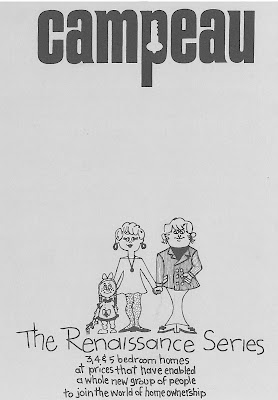Mid-Century Modern (MCM) design has become a part of mainstream culture and more and more people have a newfound appreciation for MCM housing.
 |
| Campeau Renaissance Series brochure for Carson Grove. c. 1970 |
Many of the original owners of MCM houses who bought them new in the 50s, 60s and 70s, are now selling and moving to more suitable accommodations for the next phase in their life. Quite a few of these houses seem frozen in time with so many of the original details still intact. This is something that true MCM aficionados appreciate! It is amazing how many of these houses have been so well maintained that the MCM kitchens and bathrooms have been beautifully preserved. While in the past a buyer might want to tear everything out and put in a new kitchen and bathrooms, today’s buyers seek out these original (and still functional) features.
 |
| Campeau Arlington Place/Rothwell Ridge brochure. c.1973 |
 |
| National Builder magazine 1966. |
 |
| Campeau "X-Ray House" brochure. c. 1960s |
 |
| Campeau Playfair Park brochure. c. 1966. |
 |
| Campeau Renaissance Series brochure for Carson Grove. c. 1973 |
 |
| Campeau Arlington Place/Rothwell Ridge brochure. c.1973 |
Whether you are discovering MCM design for the first time, or re-discovering it from your past, the time is right to buy that perfect MCM house!
Feel free to contact me if you would like help finding that special home:
Saul Svirplys
Sales Representative
Faulkner Real Estate Ltd.
Saul@homesinottawa.com
613-231-4663
Feel free to contact me if you would like help finding that special home:
Saul Svirplys
Sales Representative
Faulkner Real Estate Ltd.
Saul@homesinottawa.com
613-231-4663
 |
| Campeau Loyola Court brochure. c. 1972. |

What fun! Interesting to see how architects and planner thought our mid-century life would be like. I live in a 1960's minto bungalow, which we have altered with two renovations. I call it a watered down frank Lloyd wright home. The feature of the fireplace bricks going all the way up the way drives me crazy but so typical of the time. We, along with many homeowners in the parkwood hills area have open up the living room and kitchen space. It just gives us more breathing room and makes the illusions of a larger home.
ReplyDeleteAlso, good luck with your research on Bramalea. I spent 10 years of my childhood growing up in the D section. I was one of the few D sectioners that attended B.S.S. so not so aware of anything after the E section. I loved the post on the C section. It explained the imposing gate structure nr. Cavendish Cresent.
Any thought to all those British sounding street and school names?
thank you.
V. Ryan